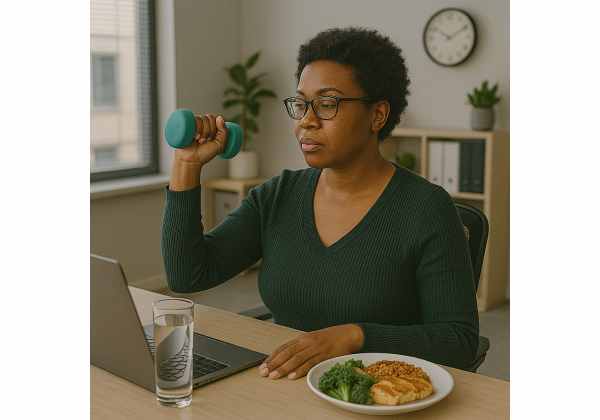
Desk jobs come with real constraints: long sitting hours, back-to-back meetings, fluorescent lighting, and a calendar that eats your lunch break. Yet office life can still support weight loss if you engineer the day with a few reliable levers. This guide shows you how to build movement into meetings, assemble meals that keep you full, and use simple mindset tools to stay consistent when work ramps up. You will leave with a weekly template, repeatable food choices, and checkpoints that prevent small detours from becoming long lapses. For a wider system that ties habits together, see our concise overview of habit, sleep and stress fundamentals.
Table of Contents
- Office worker weight loss basics
- How to move more at work
- Build meals that keep you full
- Stop desk snacking and drinks
- Mindset, motivation and accountability
- Sleep and stress for office life
- Evidence, metrics and results timeline
- Frequently asked questions
Office worker weight loss basics
Office weight loss starts with constraints, not ideals. Your calendar dictates effort windows, your building shapes movement choices, and your team culture influences food. Rather than fighting those realities, design habits that thrive inside them.
Start with a simple energy plan. Weight change responds to weekly averages, not single meals. That is good news in office life, where some days run clean and others spiral. Choose a modest calorie deficit you can sustain—think “slight nudge,” not overhaul. Pair that with protein targets and movement you can repeat when work is busy.
Anchor three daily commitments:
- Move each work block: Short bouts of movement raise daily activity without draining time. They also protect mood and focus.
- Eat to stay steady: Meals built around protein, fiber, and planned starch keep you satisfied and prevent late-day raids on the office snacks.
- Track one metric simply: You might trend your body weight, steps, or “green meals” per day. A single, objective gauge reduces decision fatigue.
What to expect from an office day. Most people sit for 7–10 hours, walk 3,000–6,000 steps, and snack when meetings stretch. The goal is not a perfect schedule; it is pattern improvement:
- Insert two to four movement “islands” across meetings.
- Standardize breakfast and lunch so you are not negotiating from hunger.
- Close the day with a brief review and a plan for tomorrow.
The plate method works at work. Half your plate vegetables (volume and micronutrients), a palm or two of protein (25–40 g), and a cupped handful of starch (rice, potatoes, whole grains). Add a thumb of fats for flavor (olive oil, nuts, avocado). This simple framework travels from home to cafeteria to takeout.
Mindset that fits office reality. You will miss walks and eat birthday cake. The difference-maker is a fast reset protocol: acknowledge the miss without drama, return to your next anchor habit, and log the day neutrally. Momentum returns when you stop negotiating with yesterday.
A weekly template to copy:
- Mon–Thu: Baseline movement blocks, standardized breakfast and lunch, protein-forward dinners.
- Fri: Same anchors, but budget room for a social meal.
- Weekend: One planning block (groceries, batch protein), one longer walk, set Monday’s first movement window.
Safety and sustainability. Rate of loss matters less than staying power. Aim for a pace that lets you work, sleep, and recover. Use our broader primer for context on target ranges and planning—see safe weight loss steps—then apply the office-specific tactics below.
Bottom line: You do not need more time. You need a few repeatable slots—five to fifteen minutes—aligned with your work rhythm. Stack those with steady meals, and progress compounds.
How to move more at work
Movement is the most flexible lever in office life. You may not control meeting length, but you control transitions, stairwells, and how you show up to calls. The aim is not sweat; it is frequency.
The three-layer movement plan
- Baseline movement (automatic):
Tie a one-minute movement to events that already happen.
- After you send a calendar invite, stand and stretch your hips and upper back.
- Every time you refill water, take the long route or one flight of stairs.
- On the hour, stand for thirty seconds, roll shoulders, and look far away to rest your eyes.
- Micro sessions (5–10 minutes):
Two or three short bouts per day move the needle.
- Brisk loop around the building before your first meeting.
- Post-lunch stroll: a ten-minute walk improves energy and steadies appetite. If you want structure, see our guide to post-meal walks.
- Quick bodyweight circuit: ten squats, ten desk push-ups, twenty marching steps, repeat three rounds.
- Intentional steps (15–30 minutes total):
Add these when the day allows.
- Walking one-on-ones or phone calls with earbuds.
- Park a few blocks away on purpose.
- Use stairs for two to three floors, elevators above that.
Set constraints that create movement.
- Calendar holds: Place two five-minute “bio breaks” per morning and afternoon. Treat them like meetings.
- Gear cues: Keep a spare jacket and comfortable shoes at your desk. Remove friction and you will use the stairs more.
- Route design: Know a two-, five-, and ten-minute loop from your desk. No decisions needed; just pick the loop that fits.
For remote workers: Replace commute steps with a ten-minute morning “commute walk.” Stand during internal calls. Use a sit-stand desk for two to four hours total, changing position every thirty to sixty minutes.
If you already train: Keep training, but do not let a missed gym session sink your activity. On high-pressure days, convert your workout to two ten-minute blocks you can slot between meetings. Consistency beats intensity in office life.
Progress checkpoints:
- Step trend up by 1,000–2,000 over the first month.
- Fewer afternoon energy crashes.
- Clearer focus in long blocks (movement breaks help your brain, too).
Troubleshooting:
- If weather keeps you inside, do hallway laps or stair repeats.
- If meetings run long, switch a micro walk to three minutes and tack two more minutes onto your next transition.
Movement is a dial, not a switch. Keep turning it up in small clicks as your schedule allows.
Build meals that keep you full
Office eating fails for two main reasons: irregular timing and low protein. When lunch slips past two o’clock, you get ravenous, overeat, and then spend the afternoon fighting sleep. The solution is not rigid calorie counting; it is structured meals you can assemble anywhere.
Your office plate, three ways
- From home (fast prep):
- Breakfast: Greek yogurt, berries, and a handful of high-fiber cereal; or eggs on whole-grain toast with spinach.
- Lunch: Protein box—chicken or tofu, pre-washed salad, cooked grains, olive oil, vinegar, nuts.
- Snack: Cottage cheese and pineapple; or an apple with peanut butter.
- Cafeteria:
- Choose a protein anchor (grilled chicken, fish, tofu, beans).
- Fill half the container with vegetables or salad.
- Add a fist of starch (rice, potatoes, pasta, quinoa).
- Sauce on the side; use enough for flavor, not a pour-over.
- Takeout:
- Bowls or plates with clear protein and veg.
- Sandwiches: add extra veg, choose whole-grain bread, and add a side salad instead of chips.
- Sushi: mix rolls with a sashimi or edamame side for protein.
Protein and fiber targets without counting.
You can “track” by structure:
- Aim for 25–35 g protein each main meal. As a rule of thumb: a palm to two palms of meat, fish, tofu, or a full cup of cottage cheese or Greek yogurt.
- Get 25–35 g fiber per day. Make vegetables the default side and include beans or whole grains once daily.
If you prefer an even simpler framework, use our non-calorie approach to protein targets and plate method to stay consistent without logging every bite.
Timing beats perfection.
Set a gentle lunch window (for example, 12:00–1:30). If a meeting overruns, grab a stopgap: a protein drink and a banana, or two boiled eggs and a piece of fruit. A small bridge saves you from a 3 p.m. pastry and a 9 p.m. pantry raid.
Desk snack criteria (choose two to three):
- 10–20 g protein.
- Some fiber or fruit.
- Individually portioned, or easy to portion.
Examples: jerky and an orange; yogurt with chia; roasted chickpeas; nuts plus baby carrots; edamame packs.
Coffee and cravings.
Coffee belongs earlier in the day. Late caffeine pushes bedtime later, making tomorrow’s cravings louder. If you love an afternoon cup, try half-caf or switch to tea by 2–3 p.m.
Hydration routine.
Place a water bottle between keyboard and monitor so you see it. Drink a glass on waking, one mid-morning, one at lunch, one mid-afternoon, and one with dinner. Sparkling water counts.
When food culture is strong at work.
Pick your moments. If birthday cake shows up weekly, take a small slice on one chosen week per month, and skip the rest. Social connection matters; consistency matters more.
Meals should make work easier, not harder. With a few defaults, you stop negotiating and start executing.
Stop desk snacking and drinks
Snacking is not the enemy; unplanned snacking is. Office environments reward grazing: candy bowls, free pastries, energy drinks at 3 p.m. To win, change the defaults you see and sip.
Design your food environment.
- Keep trigger foods out of line of sight. Transparent containers invite mindless grabs; opaque ones do not.
- Place your “green-light” snacks at eye level: Greek yogurt, fruit, edamame, nuts portioned into small bags.
- Pre-portion sweets if you keep them. One serving in a small container beats a hand in the family-size bag.
“Closed kitchen” cues at work.
- After lunch, brush teeth or use mint gum for a clean break.
- Set a standing rule: if you want something sweet, pair it with protein (yogurt and berries; apple and peanut butter), not solo candy.
Drink like a pro.
- Energy drinks and sugary coffees are stealth calories. Replace a daily large sweet coffee with a latte or flat white and save a few hundred calories per week.
- Alcohol after work lowers restraint and fragments sleep. If social drinks are part of the culture, cap at one and alternate with water.
Caffeine timing protects sleep.
Set your personal caffeine cutoff at least eight hours before your usual bedtime. Better sleep means fewer cravings tomorrow.
Office strategies that actually stick
- Keep a high-protein option in your drawer or fridge, always.
- Do not eat from communal containers; use a plate or napkin, then walk away.
- If you are vulnerable to boredom eating, schedule a ten-minute afternoon walk or quick stretch at the time you typically wander to the break room.
For a deeper home-and-office reset of default foods, skim our guide to snack swaps and pantry organization. When the environment chooses for you, you stop fighting constant urges.
Mindset, motivation and accountability
Office life challenges motivation in waves: quarter-end sprints, product launches, travel. The solution is not more willpower; it is systems that keep you showing up when pressure spikes.
Identity and purpose.
Connect your habits to your role. “I am a leader who protects energy for my team,” or “I am a parent who wants stamina for evenings.” Identity-level reasons outlast scale hiccups and busy weeks.
Implementation intentions (if-then rules).
- If my lunch is delayed by meetings, then I drink a protein shake and eat fruit at 1:30.
- If I skip my morning walk, then I take a ten-minute loop before my first afternoon meeting.
- If there are treats in the break room, then I plate one and leave.
Friction management.
- Remove friction from good habits: keep shoes at your desk, stock go-to lunches, save calendar walking routes.
- Add friction to less-helpful ones: do not keep candy at your desk, unsubscribe from food delivery promos during work hours.
Accountability that helps, not punishes.
- Share your plan with a colleague who also wants to walk more.
- Use simple weekly reviews: Did I hit my three anchors most days? What made it easier? What blocked me? Reset the plan accordingly.
- For structure you can copy, see our approach to weekly check-ins that keep progress measurable.
Motivation during slow results.
Expect plateaus. Use a process scoreboard: movement blocks completed, protein meals eaten, bedtime consistency. When the scale lags, process wins keep you moving.
Self-talk that works at work.
- Replace “I blew it” with “I missed a rep; next rep starts now.”
- Keep streaks short. Long streaks invite perfectionism; three-day streaks restart easily.
Consistency is not a personality trait; it is an environment and a plan that expect disruption and make recovery simple.
Sleep and stress for office life
Sleep and stress control appetite, focus, and decision-making—the exact capacities office work taxes. Protecting them is a performance strategy, not an indulgence.
Sleep is an evening habit powered by daytime choices.
- Aim for a stable sleep window. Most adults do best with 7–9 hours in bed.
- Put caffeine on a schedule. Switch to tea by early afternoon.
- Dim lights and screens an hour before bed; set devices to night mode.
If you want a clear target for bedtime and totals, our guide to sleep targets explains how much most people need and why it matters for appetite control.
Close the workday cleanly.
- Create a shutdown ritual: list tomorrow’s top tasks, clear your desk, and set your first movement block on the calendar.
- Avoid jumping back into email after dinner; it primes stress and invites snacking.
Stress releases you can do at work (5 minutes or less).
- Box breathing: in for four, hold for four, out for six, repeat five rounds.
- Visual reset: look far across the room or out a window for sixty seconds to relax your eyes and nervous system.
- Micro walk: three to five minutes to drop tension and return with a steadier state.
Travel and late nights.
- Use light to control your clock: morning daylight anchors wakefulness, dim evening light supports sleepiness.
- If a deadline pushes bedtime late, expect stronger cravings next day. Plan a protein-forward breakfast and a short walk after lunch; do not chase energy with sugar.
Stress-eating triage.
- Identify the cue (email, conflict, boredom).
- Replace the routine: stretch, breathe, or walk before you snack.
- Reward the new routine: check off a tiny “win” on your process scoreboard.
Sleep and stress are multipliers. Improve them slightly, and your food and movement habits get easier almost overnight.
Evidence, metrics and results timeline
You work in quarters and sprints; track health the same way. Use a simple, consistent dashboard and evaluate progress in four-week blocks.
Pick two primary metrics and one secondary.
- Primary options: average daily steps, number of movement blocks per day, “green meals” per day (meals that meet your protein and plate method criteria), weekly weight trend.
- Secondary options: waist measurement, resting heart rate, or how work clothes fit.
How to weigh without obsession.
- If you choose weight, collect data daily or three times per week and average it. Day-to-day noise is high; trends matter.
- Pair weight with behavior metrics so you do not chase the scale with random changes.
A realistic results timeline
- Weeks 1–2: Energy improves, afternoon crashes lessen, sleep steadies. Appetite becomes more predictable as meals standardize.
- Weeks 3–6: Noticeable changes in waist or clothing fit for many people. Steps and movement blocks feel automatic; lunches need less thought.
- Weeks 7–12: Trend-level weight changes become visible in photos or charts. Social flexibility feels easier because your defaults are strong.
Reinforce what works.
- Hold on to anchors that survived your busiest weeks—those are your keepers.
- When progress stalls, check your three basics in order: sleep window, protein at meals, movement frequency. Adjust the simplest one first.
When to recalibrate.
- If you are persistently hungry, add 10–20 g protein to lunch and dinner and a fist of starch at the meal before your hungriest time.
- If energy is low, push bedtime earlier and add a gentle walk after lunch.
- If the scale jumps after travel or a deadline, return to your anchors and let the average settle before changing the plan.
Remember the office advantage. Predictable days are a training ground for predictable habits. Use your calendar to place movement and meals, and your results will reflect the structure you build.
Frequently asked questions
How much should office workers walk each day?
A practical target is 7,000–10,000 steps, built from short walks tied to your schedule. Use two to three five- to ten-minute loops across the day and stairs when feasible. On heavy meeting days, protect at least two movement breaks so your average stays steady.
What is the best office lunch for weight loss?
Build lunch around protein, vegetables, and a fist of starch. Examples: grilled chicken, big salad, and quinoa; tofu bowl with mixed vegetables and rice. Keep sauces on the side. This structure controls hunger and prevents late-afternoon grazing without requiring calorie counting.
Do standing desks help with weight loss?
Alternating sitting and standing can raise daily energy burn modestly and reduce stiffness, but it is not a fat-loss engine by itself. The bigger win is movement frequency: change positions every thirty to sixty minutes and add brief walks to reliably increase activity across the day.
How do I handle constant office treats?
Decide in advance: plate a small portion on chosen days and skip the rest. Pair any sweet with protein to steady appetite. Keep your own “green-light” snacks at eye level. The goal is predictability, not perfection, so treats do not derail your weekly averages.
Is skipping breakfast helpful for office workers?
Some thrive with a later first meal, but many office workers overeat later if they skip breakfast. If you try a later start, keep lunch protein-forward and plan a balanced snack. Monitor energy, focus, and late-day cravings; choose the pattern that supports steady work.
How fast should I expect results?
Think in four-week blocks. In weeks one and two, energy and sleep usually improve. Weeks three to six bring visible changes in fit for many. By weeks seven to twelve, weight trends show clearly if your anchors are consistent. Adjust the simplest lever first when progress stalls.
References
- WHO guidelines on physical activity and sedentary behaviour 2020 (Guideline)
- Daily steps and all-cause mortality: a meta-analysis of 15 international cohorts 2022 (Systematic Review & Meta-analysis)
- Effect of Sleep Extension on Objectively Assessed Energy Intake Among Adults With Overweight in Real-life Settings: A Randomized Clinical Trial 2022 (RCT)
- The Acute Effects of Interrupting Prolonged Sitting Time in Adults: A Systematic Review and Meta-Analysis of Controlled Trials 2022 (Systematic Review & Meta-analysis)
- Exercise Prescription for Postprandial Glycemic Management 2024 (Review)
Disclaimer
This article provides general education and is not a substitute for personalized medical advice, diagnosis, or treatment. Consult your physician or a registered dietitian about your health history, medications, and goals—especially if you have diabetes, sleep apnea, a history of disordered eating, or new symptoms that concern you.
If this guide helped, consider sharing it with a colleague who wants steadier energy at work, and follow us on Facebook, X, or whichever network you prefer for future step-by-step guides on movement, meals, and mindset for real-world weight loss.










